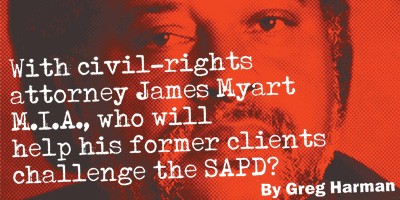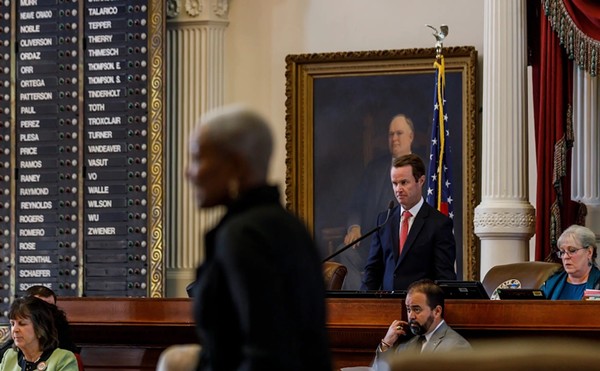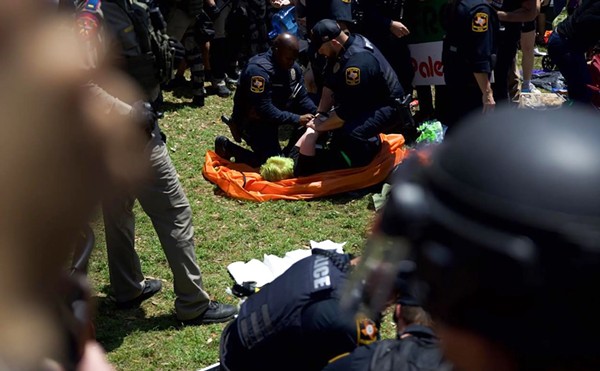It could have been a 12-step program gathered in the basement meeting room of Mt. Zion Baptist Church. There was no shortage of tears, anguish, or exhaustion. But the demons this gathering was bonding over weren’t those of personal or family addiction, but the more abusive elements within San Antonio’s Police Department.
In the slow slog for justice, the January hearing on police practices wasn’t intended to rile television audiences or mobilize a simmering crowd, it is a time to speak and be heard.
A panel from the Police Executive Research Forum have their faces buried in legal pads at the back of the room, their fingers knotted over yellow sheaves of paper. They’ve been retained by Police Chief William McManus to investigate his department’s use-of-force policies, both on paper and in practice.
After meeting with the ruling caste the night before and scavenging police files, they are on San Antonio’s East Side tonight to get the report from the street.
One after another, those bearing wounds they claim were inflicted by members of the SAPD take to the front of the room and share their grief, anger, and confusion.
A young man talks about having his pants pulled to his ankles at a city service station. In front of numerous witnesses, the man says he was penetrated by SAPD contraband-seeking latex.
“Ever since then it’s kind of hard to talk about it,” he tells the PERF representatives seated at a folding table up center, as dozens of others crowd around listening. “To me, it’s sexual assault. This cannot be right. This cannot be the way things are done.”
The stories of these self-identified victims and their families suggest it is — in too many cases — exactly that.
For years, these were the stories Civil Rights attorney James Myart’s practice guaranteed prominent placement on regional newscasts, local radio, and in untold inches of newsprint.
Moving about the room in a wide-cut suit, Myart was operating with uncharacteristic tenderness, circulating among clients, exchanging muted words with attendees, and offering handshakes all around. It is a potential watershed moment, capping years of his own efforts to draw attention to what he considers a cancer in San Antonio law enforcement. A positive outcome here will almost excuse his episodic tirades, out-and-out tantrums, and innumerable slights and slurs.
Brenda Shaw describes how a family disturbance call unraveled because of bully police tactics, resulting in her whole family being violently cuffed. How her daughter Lakisha McCalister was dropped facedown in a pile of rocks and battered. Of the seizures that started thereafter.
Sobbing, Lakisha tells the group, “I don’t know why I have seizures. And I’m going to have them for the rest of my life.”
“It needs to change,” Shaw pleads with the PERF board. “It starts with y’all, because y’all are an outside agency.”
PERF describes itself as a collection of “progressive police executives from the largest city, county and state law enforcement agencies,” dedicated to “improving policing and advancing professionalism through research and involvement in public policy debate.”
Under pressure from mounting complaints about its officers, the City commissioned PERF to conduct a use-of-force report on the SAPD. Though expected in the spring, those findings were only submitted to Chief McManus two weeks ago. After the department has drafted its response to the report, the package will be presented to the City Council and the now-simmering debate will be fed a fresh cord of kindling.
SAPD spokesperson Sergeant Gabe
Treviño said McManus would not be commenting on the report or on Myart, referring questions to the City Attorney’s office. “Obviously, the police department has systems in place for citizens to complain and express their concerns when they have a complaint against a police officer,” Treviño said. “There might be some tweaking of some of those things, with what the PERF recommendations may have, but I think those systems are in place and are effective… with some minor adjustments.”
One thing is certain, the iconic face of antagonistic resistance, James Myart, won’t have any part in the drama that will unfold from here. It’s lamentable.
I have to confess, I liked the bomb-chucking attorney from the start — from the first press conference I attended.
The City had just offered an $80,000 settlement to a young black man whose scalp was split by an SAPD bullet. After being stopped on his way to work, Joseph Fennell said he removed a set of keys from his pocket. He was matched with a shot to the head.
After snapping pics of Fennell and
Myart for a good 20 minutes, I started taking a few shots of the back of the room — the many television cameras and reporters grouped behind me. A scribbler from the Express-News brayed his objection, demanding I not take his picture.
Needless to say, the press conference stopped. The outburst cut into Myart’s presentation, which, to this point, had included his tossing a thick binder of associated police records of the incident onto the floor in a show of contempt. The showman blasted the other writer and instructed him to get out of the room.
A snap judgment. A loud — and (to me) righteouss — command.
I’ve enjoyed his other eruptions almost
equally.
There have been few local attorneys, for instance, willing to take their charges of racist police behavior before such expectantly unappreciative audiences as FOX News duo Hannity and Colmes. Fewer still eager to unload on national television gems like: “Mr. Hannity, again, as I told you, you’re just a rich, white boy who will never understand,” as Myart did in November 2006 during a segment headlined, “Do police target African-Americans?”
For the crowd at Mt. Zion, the question wasn’t even worth asking. Myart, the 300-pound pontiff of black justice, was the voice on the mountain when it came to Civil Rights in this decidedly uncivil town. Even those in disagreement with him at that meeting knew him at least as a man of action.
But Myart’s oversize zest for insinuation and disparagement in his war on the establishment caught up with him — repeatedly.
His attorney’s license was pulled for four years in 1999 on charges of professional misconduct. In April, he earned another three-year suspension for aggravated perjury. Only a few weeks later a jubilant press release scrolled out of the Current fax, blaring, “‘CIVIL RIGHTS’ ATTORNEY JAMES MYART ADMITS TO CRIMINAL WRONGS.”
As part of a plea deal, Myart pleaded guilty to not only stealing from a Habitat for Humanity store in 2005 and filing a false report about being attacked by police officers in 2006, but also to charges of pocketing $13,275 from a client.
Compounding his embarrassment, the client he admitted to wronging turned out to be the reputed founder of the Texas chapter of the Mexican Mafia, Heriberto “Herbie” Huerta.
Online forum-goers — like one gun site dedicated to the AR-15 machine gun, a police favorite — went ballistic on Myart. Comments raged from an offer of a noose to rampant speculation on Myart’s prison life expectancy.
Neither Myart nor his attorney Christopher Gale could be reached for this article.
Wherever one lines up on Myart’s rebel style — whether you consider the man rabidly racist himself or heroically uncompromising — his failings have left a gaping hole, a truly Myart-sized hole, in San Antonio’s legal network.
Drawn typically from the economic underclass, Myart’s former clients have fallen into a legal miasma. Some have found their way to new counsel, thanks to the local American Civil Liberties Union chapter. Others drift still.
St. Hedwig resident Helen Hullaby was at Zion the day that PERF members settled into folding chairs to hear from what Myart described as “a small microcosm” of San Antonio’s mistreated minorities.
Though she paid Myart $5,000 for assistance, Hullaby’s effort to gain help for her niece — as well as confront the SAPD and a local hospital — never made it to the starting blocks.
Hullaby’s niece, Terry Lynn Woods, is a 42-year-old deaf woman with a string of violent behavior to her record. Due to her unpredictable temper, something Hullaby blames on her deafness and a bi-polar disorder, Woods is not welcome to stay with family in San Antonio. So she bounces around the assisted-living circuit.
During a police confrontation at one such residence, Woods didn’t make it downtown. Instead, she found herself dumped at Nix Specialty Hospital with a fractured leg.
Hullaby said Woods told her she was having trouble getting her state disability check and blamed the owner of Rosa’s Assisted Living, Rosa Toney.
Toney said the fight was over a man talking to Woods’ girlfriend.
“She threw large rocks through all first-floor windows across the front of house. Cut phone lines. One almost hit a resident,” Toney said.
The Current was not able to locate a witness to the arrest, but police records indicate officers were dispatched to the location twice that day.
Previous calls list Woods as a repeated source of trouble.
There were repeated struggles over her medication and a brick-tossing incident. Woods was evicted.
In May, Woods returned to the home to pick up her belongings, Hullaby said. When she arrived she found her belongings piled up outside the house — but not her check.
That’s when a round of window breaking
began.
“I guess they told her to stop or whatever, and she didn’t, so they caught up with her and they handcuffed her,” Hullaby said. “They threw her in the back of the car and they just continued to beat her. Even though she was in handcuffs, they continued to beat her.”
Toney said the encounter happened up the street and she didn’t see the arrest.
Officers supposedly then took Woods and dropped her at Nix Specialty Hospital on Vance Jackson, where she was put in a splint and released.
Hullaby couldn’t find Woods for four weeks, but when she caught up with her niece, now at another assisted-living residence — one that Hullaby claims was being run by drug dealers — she found a medical emergency.
“I saw Terry and her leg was swollen all double,” she said. Hullaby and others got Woods to an orthopedic surgeon for emergency treatment.
The aunt’s primary complaint has been with the SAPD and Nix Hospital, but her hope in hiring Myart was ultimately to get power of attorney over Woods so she could get her admitted into a state hospital for long-term care.
“She needs it,” agrees Toney. “She needs it. She is out of control. She is totally out of control.”
When Myart disappeared with Hullaby’s $5,000, the woman didn’t know what to do.
“In a way, I feel like he has us in mind, but there is nothing he can do because he had his license suspended,” Hullaby says. “I need something to be done because Terry is in another boarding house and she got into it with the people. She has problems getting along with people. They called me. They all think that I have guardianship over her and I don’t.”
Clients who got lost in the Myart shuffle have a couple of options, says Maureen Ray, special administrative counsel in the Office of Chief Disciplinary Counsel for the State Bar of Texas. The first is to call the Bar’s Lawyer Referral Service to get matched with an attorney working in a field similar to their former lawyer.
Payments made to attorneys who either intentionally pocketed settlement cash or failed to provide services at all, can be reimbursed through The Client Security Fund. Amassed from the annual dues paid each year by practicing Texas attorneys, the Fund cashed out almost half a million dollars on 27 cases during 2006. Most were cases of attorneys holding fees they did not earn; 18 were found to be incidents of theft by the lawyer, according to data maintained by the Bar.
However, miffed clients can’t claim money they feel they would have been awarded if their attorneys hadn’t dropped their cases.
Keeping up with their ambulance-chasing image, personal injury lawyers were responsible for most awards paid out through the Fund.
Many of Myart’s cases were shunted to local ACLU board member Ed Piña — likely the only other Civil Rights attorney in San Antonio who handles more cases of alleged police abuse than the now off-screen Myart.
There were few venues Myart was not willing to rush into with his vociferous claims of racial profiling and unprovoked police attacks on African-Americans. Although, his behavior has earned him public derision and time in jail, such as when he grandstanded at a City Council meeting, demanding that protestors removed from the meeting be allowed back into the chambers, some of his colleagues believe such trumpeting is necessary.
While most attorneys contacted for this story failed to return repeated phone calls, Piña offered some insights.
“I certainly respect his approach to this,” said Piña. “It’s a necessary approach, and it probably permitted me not to have to raise the profile of some of my cases, which otherwise I may have been required to do in order to effectively represent them.”
Piña is a defender of Myart — at least as far as recent City actions are concerned. He spoke up for Myart when the disgraced attorney was arrested at the City Council meeting and smacked with a restraining order requiring him to stay away from City Hall and Mayor Phil Hardberger. But he has a far more sedate method of pursuing justice.
“Mr. Myart and I have always done more civil- rights work than anybody else I know of, but you know, `on` different tracks in the sense that I’m always leery of the spotlight,” Piña said. “Now, sometimes representation of your client absolutely demands `publicity` and requires it and I’d be remiss if I didn’t do it. Otherwise, I’m not going to seek it.”
Myart’s boisterousness was good for other Civil Rights attorneys in that it communicated the widespread public complaints about the police force to the public — and the potential jury pool. Myart may be able to apply for reinstatement with the Texas Bar in five years, but in the meantime, another public loudspeaker may need to step in.
“I don’t like for people to hear about my cases, but sometimes it’s necessary,” Piña said. “I think everybody in the Civil Rights community owes a debt to him, in one way or another.”
Lakisha McCalister was in the house when the police arrived. Her brothers had been fighting. But John had since gone outside. Her younger brother retreated to his room.
Then the cops showed up.
John was pulled from the yard and placed face down on the sidewalk, according to mother Brenda Shaw. Then, one by one, as the family came out of the house, there was more of the same.
In the ensuing confusion, a disbelieving Shaw recalls a female officer shoving her way past her and heading at her daughter, who had cried out, “Look what these pigs are doing to us!”
“She pushed me into the fence and balled up her fists and started going after Lakisha,” she said.
Her own arm quickly twisted behind her back by another officer, she watched as Lakisha was slammed face down in a rockpile. As a pile of blue uniforms fell upon the slight, young girl, she claims to have seen a fist rise and fall on her daughter.
“I first saw her have a seizure about two weeks later,” Shaw said. But Lakisha relates that just hours after her arrest for interfering with police business and assaulting an officer she lost control of her body.
“She said she first had a seizure in jail. They tied her to a chair and put a plastic bag over her head. They said, ‘Ah, you’re not having a seizure. You’re just faking,’” Shaw said.
Her parents say the 20-year-old now takes two medications to control her episodes.
The PERF report is unlikely to satisfy those who claim mistreatment by SAPD — and it won’t change the opinions of Brenda Shaw, who not only blames local police for her daughter’s seizures, but now has to lament the death of her son, possibly due to a Parks Police officer taking too long to call EMS after a gang-related shooting late last month.
(Though the shooting occurred on May 28, the Parks Police report had still not been filed by this week’s press deadline. SAPD, who arrived later, reported that two men were arrested for aggravated assault and aggravated robbery.)
As Myart began to recognize how his own behavior was threatening his practice, he began to soften, admitting to his own struggles to find mental clarity. A softspoken Myart closed the PERF meeting in January with a disclaimer.
“The vast majority of officers are honest, god-fearing, spiritual human beings,” he said. “But it’s more than a few bad apples, ladies and gentlemen … This is what you call anarchy in the worst way.”
If anarchy comes with the territory, it’s no wonder the Myart-sized hole may be a hard one to fill.
Any takers? •
Blacks get more than fair share of police force
Almost half of all cases involving the use of force by SAPD are attributable to officers with five years or less in the service. African-Americans, representing only 6.8 percent of the San Antonio population, were on the receiving end of 15 percent of all such cases reported by officers — a rate twice their population.
That’s according to the city’s U.S. Department of Justice-funded survey on use-of-force statistics, published in 2003. The report by William Terrell spanned 18 months of activity, from mid-2001 to the end of 2002
By comparison, such cases against Hispanics (64.9 percent) were slightly higher, by percentage, than their population of 59 percent. Anglos, representing 19.4 percent of cases, were less by two-thirds their population of 68 percent. (More than four percent of San Antonio residents declare themselves both White and Hispanic on the 2000 U.S. Census, resulting in a total racial breakdown of greater than 100 percent.)
Interestingly, Black officers were the least likely to use force when conducting their duties. White officers were most likely to pull the baton, taser, or pistol, according to the report.
SOURCE: U.S. Census Bureau/SAPD Use of Force Analysis, William Terrell, PhD.



















